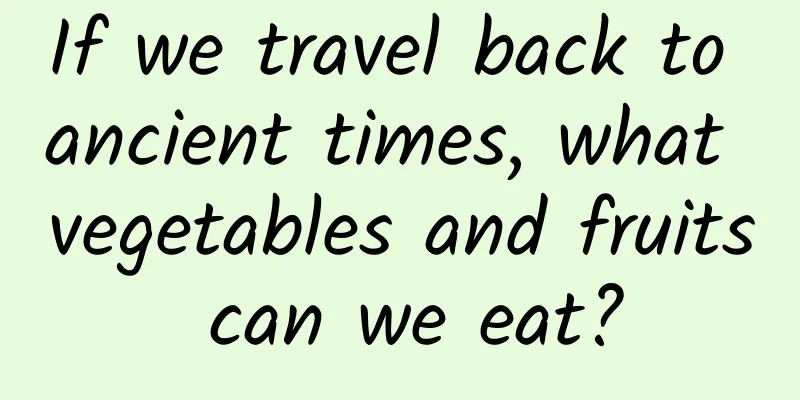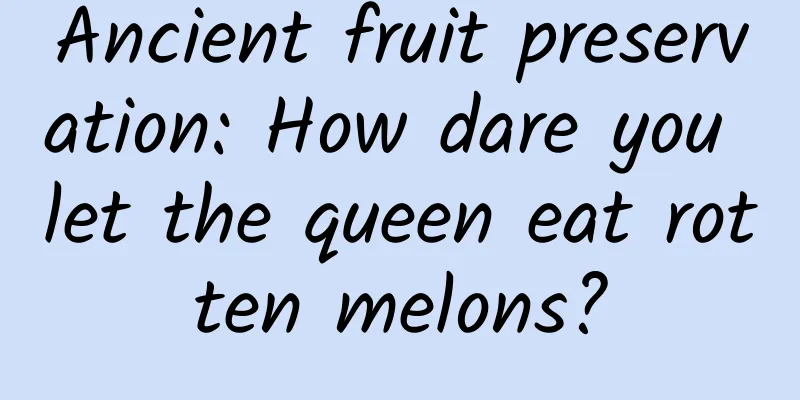If we travel back to ancient times, what vegetables and fruits can we eat?

|
Although there was no nutritional guidance in ancient times, as a biological instinct, coupled with simple experience accumulation, the ancients generally understood that diet should be balanced and that meat and vegetables should be matched. However, there were not as many vegetable categories to choose from in ancient times as there are today, so what did the ancients mainly eat? Image source: soogif 1. Five vegetables for fullness In the pre-Qin period, our ancestors mainly ate the following vegetables: leek, shallot, sunflower, onion, and 藿, which are collectively called the "five vegetables". Some of these vegetables are still regular guests on our tables today, but some are no longer common or have simply disappeared. leek Leek is the familiar leek, one of the most common vegetables. It has a long history. The Book of Songs, July, says: "On the fourth day, offer lambs and leeks as sacrifices", which shows that leeks were sacred sacrificial items at that time. However, after the Han Dynasty, leeks became a vegetable that ordinary people could eat. Because leeks have an advantage that they can be cut and grow again, and then cut again, so they can be supplied continuously. During the Southern and Northern Dynasties, there was a man named Yu Gaozhi. Because of his poor family, he could not afford meat. He ate three kinds of leek products, leek pickles, leek and raw leek, as side dishes every day. So people jokingly called him "Who said Yu Lang was poor? He often ate salmon of twenty-seven kinds", three "leeks", that is, three "nine" twenty-seven. Leek丨Image source: Paixin Creative scallion Xie (xiè) is also called jiao (jiào)tou. It looks like a shallot, but the only edible part is the small white bulb at the root. It is still grown in many places in the south and can be used to pickle pickles, but generally speaking, it has withdrawn from the mainstream of Chinese people's dining tables. At the end of the Eastern Han Dynasty, Cao Cao and Cao Zhi each wrote a poem "Xie Lu Xing", comparing time to dew on Xie leaves, which is fleeting, to express their ambitions. Onion 丨 Source: Contracted Photographer/IC photo sunflower Sunflower is not the sunflower we have today, but sunflower leaf, which is also called winter vegetable now. Its young leaves can be used to make soup. It had a very high status in ancient times. Wang Zhen's "Book of Agriculture" in the Yuan Dynasty said: "Sunflower is the master of all vegetables." At that time, every household planted sunflower leaf, just like we plant Chinese cabbage in every household now. But after the Ming Dynasty, it was gradually abandoned by humans because of the high fiber content in its stems and leaves, which made it not very delicious to eat. It was only planted in some areas such as Hunan and Jiangxi, and it has become a wild vegetable in most areas. Winter vegetables丨Photo source: Yitu.com onion Scallions need no introduction. They are a common vegetable in our daily life. They can be used as condiments, dips, or made into pancakes with scallions by Shandong people. They are crunchy when eaten. Scallions are beautiful, graceful, and distinctly green and white. They are very beautiful in the eyes of Chinese people, so they are often used to describe beauties, such as the "fingers of Liu Lanzhi, a pretty daughter-in-law, like the roots of scallions" in the Han Dynasty Yuefu "The Peacock Flies Southeast". "Scallions" are used to represent the green color. "Lush" and "green" are both used to describe a green color like jade. The lush growth of plants is called "lush and green". Onion | Source: Paixin Creative Agastache rugosa Huo refers to the tender leaves of soybeans. Like sunflowers, it is mainly used to make soup. The Book of Songs, Xiaoya, Baiju, recites in the voice of the Zhou emperor: "The bright white colt eats the Huo in my field." The white colt refers to a virtuous person with high moral character, and Huo leaves represent the salary of the court. The poem says: Since you have eaten the tender leaves of soybeans in my field, why don't you stay and serve as an official in my court? However, when the bean leaves are a little older, the fiber content increases and they become unpalatable. Therefore, in ancient times, it was mainly eaten by ordinary people. "Huo food" means eating poorly, which is the opposite of "meat food". Soybean leaves | Source: Contracted photographer/IC photo 2. Exotic vegetables During the Western Han Dynasty, explorer Zhang Qian opened up the road from the Central Plains to the Western Regions, which is the famous Silk Road in history. Since then, a large number of vegetables and fruits cultivated in the Western Regions have come to the Central Plains and gradually conquered the tables of our ancestors. Because people at that time called the people of the Western Regions "Hu", these vegetables were often named "Hu", such as carrots, sesame, cucumbers and garlic. Carrot | Source: Paixin Creative The Tang Dynasty had frequent exchanges with neighboring countries, and a large number of new vegetables were imported from foreign countries. The most famous of these was the handsome spinach. Spinach originated in Persia (now Iran) in western Asia 2,000 years ago. During the reign of Emperor Taizong of the Tang Dynasty, Nepal introduced spinach seeds to China as tribute. When it first came, it was called pineapple (léng) according to the transliteration, and later it was shortened to spinach. In addition, chrysanthemum, lettuce, fennel, etc. were also introduced from foreign countries during the Tang Dynasty. spinach During the Ming and Qing dynasties, European colonists sailed across the ocean to China, bringing with them specialty vegetables from all over the world. At that time, people called foreign countries "Fanbang" and foreigners "Yangren", so vegetables often had the word "Fan" or "Yang" in their names, such as tomatoes, sweet potatoes, onions, and cabbage. Is the sweet and sour tomato a vegetable or a fruit? We have never figured it out, but it doesn't stop us from tasting it. However, when this plant, which is native to the Andes Mountains in South America, first came to Europe, it was called "wolf peach" and was considered highly poisonous, so no one dared to take a bite. Later, people discovered that this colorful little thing was so delicious. Tomato丨Photo source: Paixin Creative Although some vegetables do not have the word "Hu", "Fan" or "Yang" in their names, they were also introduced from foreign countries. For example, the pumpkin native to South America and the bitter gourd native to India were both brought back from foreign countries by the fleet of Zheng He, a famous Ming Dynasty navigator. 3. Ancient Fruits Before the Qin and Han Dynasties, the five most popular fruits in the Yellow River Basin in the north were: jujube, plum, apricot, chestnut, and peach. Peach trees are a native plant in my country. As early as the Hemudu culture era more than 4,000 years ago, our ancestors had learned to cultivate peach trees, because archaeologists found carbonized peach pits in their tombs. By the Western Zhou Dynasty, peach trees had become a frequent visitor to every household orchard. There is a sentence in "The Book of Songs Wei Feng" that "there are peaches in the garden, and the fruits are eaten", which means that if you plant peach trees in your backyard, you can pick the fruits as a delicacy. It can be seen that in the earliest times, people planted peach trees purely for eating its fruits. When they no longer needed to eat peaches to satisfy their hunger, they discovered the beauty of peach blossoms, so peach trees gradually became a symbol of beauty in people's hearts. Tao丨Photo source: Paixin Creative Ancient people often used dates and chestnuts together, probably because these two kinds of dried fruits can grow and bear fruit in particularly harsh environments, and can be eaten as food during famines, so there is a saying among the people: "Chestnuts can't be killed by drowning, and dates can't be killed by the sun." Probably because of their great uses, dates and chestnuts also have an important position in ancient etiquette. "Zhou Li" stipulates that when a newly married daughter-in-law visits her parents-in-law, she must bring dates, chestnuts and dried meat as gifts. "Date" is homophonic to "early", which means that you should be diligent and get up early in the future; "chestnut" is homophonic to "stand", which means that you should be self-reliant and self-reliant. Date丨Source: Paixin Creative In the Yangtze River Basin, the most popular fruits are tangerines, oranges and grapefruits. Members of the citrus family are all native to my country. About 4,000 years ago, Dayu became king and divided the world into nine states. He required each state to regularly provide the best local products to the Yu Dynasty. The tribute list of Jingzhou included tangerines. Since then, the status of tangerines has never been shaken, and it has been a special commodity for the royal family in every dynasty. 4. Fruits from far away During the Western Han Dynasty, Zhang Qian brought back a large number of fruits from the Western Regions, including grapes and pomegranates. By the Tang Dynasty, grapes were already widely planted in many places in northern China. Wang Han, a poet of the Tang Dynasty, wrote a poem called "Liangzhou Ci": "Grape wine in a luminous cup, the pipa urges me to drink, don't laugh at me sleeping drunk on the battlefield, how many people have ever returned from the battles in ancient times." This shows that our ancestors already knew how to make wine with grapes at that time. "Oranges, Grapes and Pomegranates" by Lu Zonggui of the Southern Song Dynasty | Source: Yitu.com The most expensive fruit in the Tang Dynasty was of course lychee, but lychee only grows in tropical areas in the south and is very delicate. After being picked, "the color changes in one day, the fragrance changes in two days, and the taste changes in three days", so it can only be transported to the north as fast as possible for people to enjoy. In addition to it, other fruits produced in the south include longan, olives, bayberry, etc., which were very expensive in ancient times. The common watermelon now was introduced from the Western Regions during the Five Dynasties. Hu Qiao said in "Records of the Captured Prisoners": "Then we entered the plains, where there were many plants and trees, and we began to eat watermelons. It is said that the Khitan defeated the Huihe and obtained this kind of seed, and planted it in a shed covered with cow dung. It is as big as Chinese winter melons and tastes sweet." This is the first time the word "watermelon" appeared in Chinese written records. Song Zhao Chang's "Lychee Picture" | Source: Yitu.com In the Ming and Qing dynasties, a large number of new varieties of fruits were brought from Western countries, such as pineapples and pitayas. In ancient my country, apples were called "nai" (nài), but they were the uncommon cotton apples. The bright red Western apples were first planted by American missionaries in Yantai, Shandong in 1871. With the large-scale promotion of Western apples, the cotton apples native to China gradually disappeared from people's sight. The word "apple" was monopolized by Western apples, and the "Red Fuji" introduced in the late 20th century almost became synonymous with apples. Author: Andes Chenfeng, a popular science writer. Review experts: Huang He, Li Chunli, Chen Tao, Xu Xiaoping Source: Chongqing Science and Technology Museum Statement: Except for original content and special notes, some pictures are from the Internet. They are not for commercial purposes and are only used as popular science materials. The copyright belongs to the original authors. If there is any infringement, please contact us to delete them. |
<<: Henan, it really hits the spot!
>>: I am not fat, so fatty liver has nothing to do with me? No! Thin people should also be careful!
Recommend
Operations uncle: The circle of friends exploded! Let’s talk about why the constellation QR code of the Plato app can be all over the circle of friends overnight!
I'm sure all of you in your circle of friends...
How "anti-human" is the right-angle shoulder? Orthopedic doctors tell the truth...
Review | Li Nannan is the vice president of Hunan...
What are the functions of Foshan Maternal and Child WeChat Mini Program? How much does it cost to develop a WeChat mini program?
As a typical representative of the market segment...
Analysis and application of commonly used brushes in Photoshop
Analysis and application of commonly used brushes...
Who are the Chinese “old residents” on the far side of the moon?
Since the impact craters on the back side of the ...
How much does it cost to customize a designated driver app in Zhaoqing?
The mini program provides convenience for publici...
Comfort you when you are unhappy, and be happy with you when you are happy... How far are we from such a robot?
Citation: When it comes to emotional robots, scie...
Content Marketing: From Planting Grass to Building Brand IP
What exactly are we talking about when we talk ab...
The "Ocean One" in the old captain's diary marks the starting point of my country's ocean-going scientific research!
Model of the research vessel "Dayang No.1&qu...
Case review + fission methodology | Why is your fission activity ineffective?
I recently chatted with a fellow operations partn...
Apple iOS/iPadOS 14.7 Release Candidate released
Apple today released the RC version (18G68) of Ap...
Xiaohongshu Enterprise Account Operation Strategy!
As fertile soil for the rise of emerging brands, ...
How can a novice master Dreamweaver? How to build a Dreamweaver website?
How to play the Dreamweaver website for beginners...
When spring comes and flowers bloom, go to the mountains, but don’t neglect ice and flood prevention!
Some time ago, when people were immersed in the b...
Why can iPhone only be upgraded and not downgraded?
Why does Apple only allow upgrades but not downgr...









